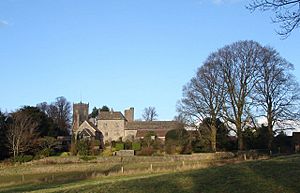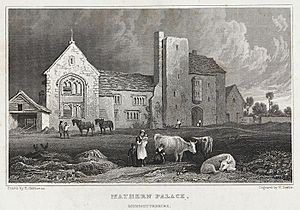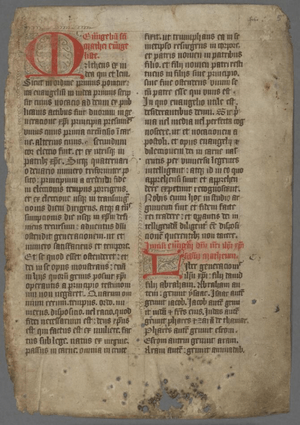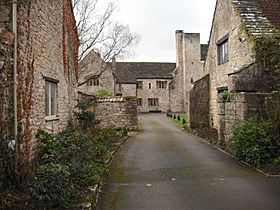Mathern Palace facts for kids
Quick facts for kids Mathern Palace |
|
|---|---|
 |
|
| Location | Mathern, Monmouthshire, Wales |
| OS grid reference | ST 523 908 |
| Built | 14th – 17th centuries Restored 1894–99 |
| Architect | Original: various Restoration: Henry Avray Tipping |
|
Listed Building – Grade I
|
|
| Designated | 10 June 1953 |
| Lua error in Module:Location_map at line 420: attempt to index field 'wikibase' (a nil value). | |
Mathern Palace is a very old and important building in the village of Mathern, Monmouthshire, Wales. It is about 3 miles (5 km) southwest of Chepstow, near the Severn Estuary. For almost 300 years, from about 1408 to 1705, it was the main home for the Bishops of Llandaff.
After it became a ruin, a writer and garden designer named Henry Avray Tipping brought it back to life. He restored the palace and created its beautiful gardens between 1894 and 1899. In recent years, Mathern Palace has been a private home and also used as a guest house. It is a special place, recognized as a Grade I listed building, which means it is very important historically.
Contents
Discovering Mathern Palace's Past
The story of Mathern Palace goes way back! An old book called the Liber Landavensis says that the land around Mathern was given to the Bishops of Llandaff. This gift was made by a king named Meurig ap Tewdrig to honor his father, Tewdrig. Tewdrig was a king who was hurt in a battle with the Saxons around the year 630. He died in Mathern, and the local church, St. Tewdric, was built where he passed away. The bishop's home was then built nearby.
The bishops likely chose this spot because it was close to a busy crossing point over the Severn estuary. Also, nearby castles like Caldicot Castle and Chepstow Castle offered protection from attacks.
How the Palace Changed Over Time
By 1333, Mathern was one of three important homes for the Bishops of Llandaff. The other two were at Bishton and Llandaff. After a Welsh rebellion led by Owain Glyndŵr in the early 1400s, the other two homes were destroyed. Mathern Palace was the only one left standing and usable.
It is thought that Bishop John de la Zouch, who was bishop from 1408 to 1423, rebuilt parts of the palace. There is even a stone from 1419, showing how old some parts are. Later, other bishops like John Marshall (1478-1496) and Miles Salley (1500-1516) might have made the palace even bigger.
However, the palace started to fall apart during Bishop Anthony Kitchin's time (1545-1563). The last major updates before the late 1800s were done by Bishop Francis Godwin (1601-1617). He added new windows to one part of the building. The palace stopped being used after Bishop William Beaw died in 1705. Parts of it were even taken down around 1770. By 1794, the buildings were rented out for farming. An old report from 1801 said the palace was "in a sad state" but still showed signs of its past greatness.
Bringing the Palace Back to Life
In 1889, the property was sold to a local lawyer. Then, in 1894, it was bought by Henry Avray Tipping. He was a famous writer about architecture and a garden designer. Tipping found the palace in a very bad state. The roofs were gone, and the inside was ruined. Parts of the old palace, like the banqueting hall, had been turned into farm buildings. The chapel was even used as a dairy, and the kitchen as a stable!
Tipping decided to restore the palace to be his home. He followed special rules for fixing old buildings to keep their history. By 1899, he had not only restored but also made the house bigger. He also created beautiful, natural-looking gardens around the palace. These gardens were in a style called "Arts and Crafts," inspired by famous gardeners like William Robinson and Gertrude Jekyll. Tipping even wrote an article in Country Life magazine in 1910, explaining how he carefully restored the palace.
Later Years of the Palace
After his mother and brother passed away, Tipping rented out Mathern Palace in 1912 and then sold it in 1914. During the First World War, it was used to house refugees from Belgium.
Later, in 1923, a man named Col. D. J. C. McNabb bought it. His wife lived there until 1957. Then, a big steel company bought the palace to use as a guest house for their workers. After that, it was owned by other large steel companies.
In August 2014, Mathern Palace was sold again and became a private home. In 2019, it was put up for sale once more.
Exploring Mathern Palace's Design
You reach the palace through what is left of a gateway from the early 1400s. On each side of this gateway, there is a small house designed by Henry Avray Tipping. The main palace building looks a bit uneven, which suggests that the bishops might not have had a lot of money and added to the building bit by bit over time. The palace was given Grade I listed building status on June 10, 1953, meaning it is very important.
In 2011, experts looked closely at the building to record its old parts. They found four main historic sections that are still standing:
- The Northwest Wing: This part was greatly updated by Tipping. He rebuilt the floors to show the wooden ceiling beams. He also added two stone supports called corbels with the symbols of the Llandaff church and his own family.
- The Chapel Wing (East Wing): This section has a chapel on the first floor. It was probably built in the early 1500s and has an impressive medieval window with four sections.
- The Central Section: This area has many old wooden beams and joists that form a beautifully decorated ceiling. Below it is a long room from the 1500s called a parlour.
- The Tower: This is a three-story part above the main entrance. It still has many old medieval features that have not been changed, like stone windows with vertical bars called mullions. It also has the remains of an old toilet chute called a garderobe. Some parts of the tower might be from the 1300s. Tipping added more parts to the building, including a third wing. The inside of the building was changed by Tipping and later owners, so it can be a bit tricky to understand its original layout.
The Beautiful Gardens of Mathern Palace
The gardens are located around the house, to the northwest, southeast, and southwest. Henry Avray Tipping created terraces on the slope facing southwest. He also turned the remains of old medieval fishponds into pretty ornamental ponds.
To the southeast, he designed formal lawns, a kitchen garden, and a sunken rose garden. Paths made of limestone and grass, lined with walls and hedges, connect these different areas. Tipping also used some of the old ruined walls as part of his garden design. He built a rock garden on the steeper slope to the northwest of the house. He planted many trees and bushes, including a large round shelter made of yew trees on the highest terrace.
Visiting Mathern Palace
Mathern Palace is a private home and is not open to the public.




